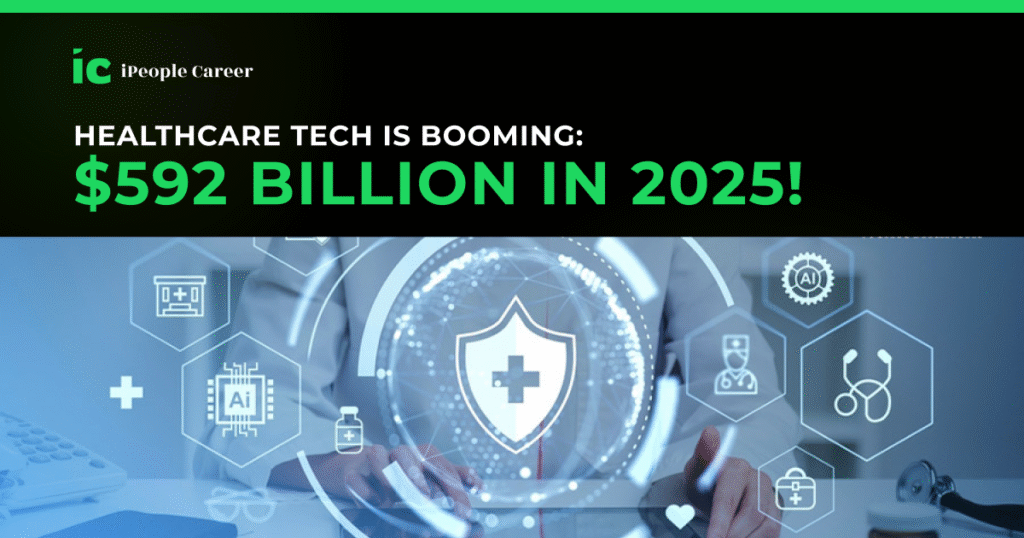
Did you know that Global Healthcare Technology spending is expected to reach around $592.49 billion in 2025?
That’s a huge number. Healthcare is changing and growing clearly at such a speed. Technology is able to change all things, ranging from diagnosis to daily care.
If you’ve been watching the healthcare space closely, you’ll know that the last few years have been a turning point. Remote consultations are what we have done when appointments are no longer in-person only. Basic fitness trackers can be smart wearables that alert you before a heart problem happens.
And this is just the beginning.
In 2025, healthcare tech is expected to become smarter, faster, and more personal than ever before. But should we be paying attention to something specific? What might that be? In the coming year, what trends will shape healthcare’s future?
Let’s break it down, trend by trend, so you know what’s coming and why it matters. Whether you are considered a healthcare professional, a tech enthusiast, or just someone who cares about better health, this one’s for you.
Healthcare Technology Trends To Watch In 2025
It is because of emerging healthcare technologies that the healthcare world is evolving at a rapid pace. In 2025, we’re not just expecting improvements; we’re expecting a complete transformation in how care is delivered, accessed, and personalized.
1. AI-Powered Diagnostics

Imagine walking into a clinic, getting a few scans or blood tests, and receiving accurate diagnostic results in minutes, not hours or days. That’s the power of AI in healthcare.
In 2025, AI-powered diagnostics are set to become a routine part of clinical decision-making. These smart tools don’t just speed things up; they spot patterns that human eyes might miss. AI can process massive amounts of data faster and more accurately than ever before, including detecting rare cancers to analyzing MRI scans.
The AI Healthcare Market is expected to reach $164.16 billion by 2030, and diagnostic imaging will be one of its fastest-growing segments.
Why it matters:
- Earlier treatment comes after a faster diagnosis, which can save more lives in conditions such as stroke, sepsis, or cancer.
- It helps reduce human error, especially when doctors are overwhelmed or understaffed.
- Patients in remote or underserved areas can get better access to expert-level diagnostics without needing to visit top-tier hospitals.
AI won’t replace doctors, but it will help them make better, quicker decisions. And in 2025, that could mean the difference between a close call and a full recovery.
2. Virtual Care And Telemedicine
Remember when seeing a doctor meant crowded waiting rooms, travel, and delays? Not anymore. Telemedicine became a disruptor and is still expanding in 2025.
Due to digital health tools and secure platforms, more patients now meet their doctors online than in person. Better video technology also contributes to the rise of virtual appointments for patients. Virtual care is helping busy working professionals, seniors who can’t travel, and people in remote areas obtain timely medical help, and it’s not just about convenience.
A McKinsey report shows that Telehealth usage has stabilized at levels 38 times higher than before the pandemic.
Why it matters:
- Faster access to care, especially for follow-ups, minor illnesses, or chronic condition check-ins.
- No travel and with no overheads means lower costs for providers and patients.
- Healthcare professionals can manage their schedules with increased flexibility at work. They also have the ability to work across locations.
- Clinics have a larger reach now, serving patients far from where they are.
Virtual care isn’t a temporary fix; it’s now a fundamental part of modern healthcare. And in 2025, it’ll be even more seamless, smarter, and more widely accepted.
3. Wearable Health Devices

What if your watch could save your life? In 2025, wearable health devices will no longer just track your steps; they’ve become your personal health assistant.
From smartwatches that detect irregular heartbeats to biosensors that monitor glucose levels in real time, wearables are helping people stay on top of their health like never before. These tools give a useful constant stream of data for users and for doctors without constant visits to hospitals.
The global Wearable Medical Device Market is expected to reach $168.29 billion by 2030.
Why it matters:
- Continuous monitoring of activity, stress, sleep, oxygen levels, and heart rate helps in the early detection.
- Better managing chronic diseases for patients who have diabetes, hypertension, and heart conditions.
- Patients take action plus are more aware of their health, empowered and motivated.
- Doctors are able to monitor patients even from afar and receive remote care support that steps in before conditions worsen.
Healthcare is now turning more proactive as a result of wearables. Healthcare was once reactive due to wearables. AI integration alongside more advanced sensors will make them smarter and more accurate in 2025.
4. Personalized Medicine
Imagine getting a treatment plan designed specifically for you—not just based on your condition, but on your genes, your lifestyle, and how your body responds. That’s exactly where healthcare is headed with personalized medicine.
Doctors are moving away from just a one-size-fits-all approach. Doctors now tailor individual patient treatments using data and genetic perceptions. It is more effective, often faster, and smarter, especially for cancer, autoimmune diseases, and rare genetic disorders.
The global Personalized Medicine Market is projected to reach $869.9 billion by 2030.
Why it matters:
- Therapies based on how you uniquely respond to medications mean higher success rates in treatments.
- Reduced side effects, avoid trial-and-error because treatments target the right pathways.
- Faster diagnosis through genetic testing and predictive analytics.
- Outcomes that are especially better long-term for complex chronic patients.
Personalized medicine will be the new standard by 2025 as more hospitals integrate AI, data analytics, along genomics.
5. Genomics In Preventive Healthcare
What if doctors could predict a disease before you ever felt a symptom? That’s the promise of genomics in preventive healthcare, and it’s becoming very real, very fast.
Genomics identifies risks for cancer, heart disease, and diabetes. A person’s DNA is analyzed early in this process. This lets people change their lifestyles. Preventive treatments are able to begin prior to when an illness. It’s not science fiction, it’s science at work.
The global Genomics Market is expected to reach $94.86 billion by 2030, driven by the demand for early diagnosis and precision medicine.
Why it matters:
- Early detection = better survival rates. The sooner a risk is found, the easier it is to manage or even prevent.
- Personalized prevention plans tailored to your genetic risk factors, not just your age or symptoms.
- To avoid major treatments along hospitalizations can save on the costs in the long run.
- Patients with an understanding of health risks are empowered to take charge of their well-being.
In 2025, genomics will sit at the heart of a proactive healthcare system, a shift in focus to prevent rather than to treat.
6. Data Management And Governance
Let’s face the fact that healthcare runs on data. Lab results scan patient histories, prescriptions, and insurance records, and the pace is growing in an overwhelming way. This data overload, lacking control plus real data handling, becomes disorder.
In 2025, healthcare organizations are prioritizing safer, smarter, and more structured data systems. It’s about making information accessible, secure, and usable in real time, not just storing it.
The global Healthcare Data Management Market is projected to reach $1.16 billion by 2030, fueled by rising digitalization and data-driven decision-making.
Why it matters:
- To give doctors the right data at the right time leads to more rapid, informed decisions during treatment.
- For improved patient outcomes, unify patient records to coordinate better and reduce medical errors.
- Stronger data privacy and compliance, especially with global regulations like GDPR and HIPAA.
- AI models that are reliable do require AI-ready infrastructure, which is clean, governed data.
- Cost reduction by eliminating data silos, redundancies, and manual record-keeping.
As data becomes the foundation of every healthcare innovation, managing it right is no longer optional; it’s mission-critical.
7. Sustainable Practices In Healthcare
Let’s be honest, healthcare saves lives, but it also leaves a pretty big footprint on the planet. Hospitals are among the most energy-intensive buildings, and the sector generates tons of waste daily. But that’s starting to change.
Sustainability is now much more than simply a buzzword in 2025. Healthcare leaders rethink how to deliver care now. They now have this as a main duty because harming the environment must be avoided.
The healthcare sector contributes 4.4% to 5% of Global Greenhouse Gas Emissions, and pressure is mounting to reduce it. Over 80 countries and areas have committed to Strengthening Climate Resilience and Reducing Emissions within their health systems.
Why it matters:
- Hospitals aim to cut energy usage by adopting efficient green building designs, HVAC systems, and smart lighting.
- Waste is reduced through improved supply chain plans as well as greater medical packaging recycling.
- Hospitals are prioritizing sustainable procurement at present. They are opting for reusable products in addition to eco-friendly suppliers.
- Telemedicine helps reduce travel-related emissions by minimizing the need for in-person visits.
- Digital records are replacing paper-based systems, helping save trees and streamline operations.
Sustainable healthcare isn’t just about saving the planet, it’s about creating a healthier future for everyone, including the generations to come.
8. Mental Health Solutions

Let’s face it, mental health has long been the overlooked part of healthcare. But in 2025, that’s changing fast. With rising awareness, shifting cultural attitudes, and advanced technology, mental health is finally getting the attention it deserves.
This year, innovation focuses on mental health care. It seeks to make such care more accessible, affordable, and customized.
The global Mental Health Technology Market is projected to grow from $3.5 billion in 2023 to $15.4 billion by 2030, showing just how quickly this space is expanding.
Why it matters:
- Mental health support is available around the clock, with AI-powered therapy apps removing waiting rooms and delays. CBT-based tools, personalized coping strategies, as well as mood tracking are available for users.
- Virtual counseling platforms are connecting patients with licensed therapists all over the globe. Therefore, geographic barriers and stigma are reduced.
- Wearables and smart devices are now tracking more than steps because they’re monitoring stress levels and sleep patterns in addition to early signs of anxiety or depression.
- Workplace mental health programs are getting a boost through tech-driven platforms offering anonymous support, guided meditation, and resilience training.
- Chatbots and conversational AI are handling mental health screenings and initial assessments to help triage patients and guide them to the right care faster.
Mental health tech involves dignity and access and support, giving people just what they need and when they need it most, for them, not just convenience.
9. Agentic AI In Back Office Operations
Let’s face it, healthcare admin work is actually so exhausting. Claims processing, reporting, billing, and scheduling all consume money and time. But in 2025, a quiet revolution is taking place in the background. It’s called Agentic AI, and it’s transforming how healthcare systems run behind the scenes.
This isn’t just automation: it’s clever AI for decision-making. Human teams can then focus on care over paperwork because they can act autonomously.
In 2025, healthcare organizations using AI for Administrative Tasks are projected to reduce operational costs by up to 25%.
Why it matters:
- AI-powered agentic smart scheduling assistants automatically manage appointments plus resource planning with doctor availability, free from human intervention.
- AI understands policy rules, detects errors, also files claims faster than ever, so billing and claims processes are streamlined, minimizing denials and delays.
- AI chatbots and virtual agents can handle internal HR and IT queries, and this improves employee experience in hospitals and clinics. Also, they do reduce helpdesk workloads.
- AI improves inventory management with procurement, predicting supply needs, plus tracking usage. It also puts orders in automatically, which cuts shortages and waste.
- Agentic systems for monitoring records, identifying missing documentation, and flagging issues before audits enable real-time compliance tracking.
Agentic AI does not wear a lab coat, yet it is now becoming the digital backbone within modern healthcare since it works so quietly, efficiently, and tirelessly to support all of the people who care for us.
10. 3D Mapping And Spatial Analysis

What if doctors could “see” inside the human body in 3D, before making a single incision? That’s no longer sci-fi. In 2025, 3D mapping and spatial analysis are transforming how we diagnose, plan treatments, and even design hospitals.
It’s not just about better images; it’s about better decisions, fewer risks, and more personalized care.
The global medical 3D Imaging Market is expected to hit $5.4 billion by 2027, driven largely by demand in surgical planning and diagnostics.
Why it matters:
- Surgeons are using 3D imaging to map out complex procedures in advance, reducing surgery time and improving accuracy, especially in orthopedics, neurology, and oncology.
- Medical training is evolving, and students use those engaging 3D simulations, which help them to learn all of anatomy and to practice procedures to understand complex cases without live patients.
- Custom prosthetics and implants are being designed with precise 3D data, improving fit and comfort for patients while speeding up manufacturing.
- Spatial analytics within hospitals helps to optimize layouts as well as reduce patient wait times, plus improve emergency response since they analyze just how people move through all physical spaces.
- Detailed spatial models offer shared access for collaborative plans by doctors, radiologists, and engineers. This kind of planning process is now more about collaboration.
Beyond just pretty visuals, 3D mapping is reshaping healthcare, making it safer, smarter, and more human, and improving care and professional training.
Conclusion: The Future Is Here!
Healthcare in 2025 is smarter, faster, and more personalized, going from AI-powered diagnostics to sustainable practices and smart back-office operations. Innovations are not distant anymore. They’re reshaping how care is delivered at present, and that makes healthcare more efficient, accessible, and human-centered.
The trends we’ve explored aren’t just industry shifts; they’re signals of what patients, providers, and innovators need to pay attention to. Stay informed if you’re part of this space, adapt quickly now, and build for the future, most importantly.
In case you are hiring skilled professionals or are exploring healthcare career opportunities, iPeople Career connects the right talent and also the right innovation, since healthcare transformation starts with the right people.
Thanks for reading, see you in the next blog!
FAQs
Q- How is AI shaping the future of healthcare in 2025?
A- AI is reshaping healthcare by improving diagnostic accuracy, simplifying admin processes, and tailoring treatments to individual patient needs. AI-driven tools are helping detect diseases like cancer earlier and assisting doctors with predictive insights that improve patient outcomes.
Q- Will telemedicine continue to grow in 2025?
A- Yes, telemedicine is expected to keep expanding in 2025 as patients and providers prioritize convenience and accessibility. With advancements in virtual care platforms and growing acceptance, remote consultations are becoming a regular part of healthcare delivery.
Q- What is digital health, and how will it impact 2025 healthcare?
A- Digital health uses technology such as mobile apps, wearables, and electronic health records to track, manage, and enhance overall health and well-being. In 2025, it’s making healthcare more connected, data-driven, and patient-centered, leading to faster decisions and better health outcomes.
Q- Is wearable technology revolutionizing healthcare?
A- Absolutely. Wearable devices now provide real-time insights into heart rate, sleep patterns, oxygen levels, and more, helping both patients and doctors make informed decisions. They’re playing a key role in preventive care, chronic condition monitoring, and encouraging healthier habits.




